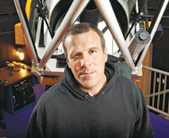Eye on the sky
UVic expertise helps build the world's largest telescope

new telescope
By Greg Pratt
Imagine a telescope so powerful that it would let you see a loonie coin being held by someone in Calgary—from Victoria. Sound far-fetched? The technology is closer to reality than you think.
An international team of scientists and engineers is currently building the world's largest and most advanced optical telescope—the Thirty Meter Telescope (TMT)—and University of Victoria researchers are playing a key role in its development.
When the TMT starts observing the sky in 2019, astronomers will be able to detect and study light from the earliest stars and galaxies, analyze planets around nearby stars, and test many of the fundamental laws of physics.
The TMT project team has selected the summit of Mauna Kea on the Big Island of Hawaii as its preferred site.
With its 30-metre diameter mirror, the TMT will have nine times the light-gathering power of the largest telescopes in use today and more than 10 times the resolution of the Hubble Space Telescope.
"TMT will be 200 times more powerful than the largest telescope currently in operation," says Dr. Luc Simard, an astronomer with UVic's Department of Physics and Astronomy and the Herzberg Institute of Astrophysics. "It will literally show us the birth of galaxies, stars and exoplanetary systems."
The TMT project is a partnership among the California Institute of Technology, the University of California, and the Association of Canadian Universities for Research in Astronomy (ACURA).
Simard is the science instruments group leader for the TMT project. "We currently have three main teams spanning 15 different institutions—not to mention industry—and two continents," he explains. "It's already a big job, and it will get bigger as our new partners—Japan, China and India—get integrated into the instrument teams and we get started on actual construction."
Another key UVic contributor to the telescope project is mechanical engineer Dr. Colin Bradley and his adaptive optics team, which is developing a solution to one of the main challenges facing TMT observations—turbulence from the Earth's atmosphere.
The TMT will have a set of deformable mirrors that "will basically change shape in real time to compensate for image distortions caused by the Earth's atmosphere," says Bradley. "In terms of the engineering, this is an extremely complex system. Canada is a world leader in this kind of work."
Simard's research interests are the formation and evolution of distant galaxies. "I'm an astronomer who has learned to translate science into engineering and engineering into science. You can't take courses for this. It has to come by osmosis, although others call it 'baptism by fire,'" he laughs.
Simard's TMT experience is reflected in course material he prepares for his graduate course in instrumentation, and it is often a focus of class discussions.
"We talk about everything from creating artificial stars up in the atmosphere using powerful lasers, to developing deformable mirrors that can change shape hundred of times a second."
The telescope isn't just about the discoveries that it will help make, stresses Simard. It's also about taking astronomical instruments to the next level.
"TMT represents a change of scale for astronomers," says Simard. "We're used to building instruments that are the size of a small car. Now we're talking about instruments that are the size of a house."View as PDF (233K).
- TMT's primary mirror has a diameter of 30 metres. It is 300 times bigger in terms of light-gathering power than the Dominion Astrophysical Observatory's Plaskett Telescope on Little Saanich Mountain, visible from most parts of Victoria.
The TMT will be able to see objects that are 300 million times fainter than the faintest star visible to the naked eye. - The diameter of the TMT dome will be 66 metres. By comparison, the wingspan of a Boeing 747 jet is 69 metres. The dome is being designed and built in Canada.
- UVic astronomers are world-renowned for their work in the formation of galaxies, stellar structure and evolution, and theoretical and observational cosmology.
- UVic astronomers work closely with colleagues at the nearby Herzberg Institute of Astrophysics to form one of the largest concentrations of astronomy talent in Canada.
- UVic researchers were awarded more than $104 million in outside research grants and contracts in 2008/09—more than double the research support of five years ago.
